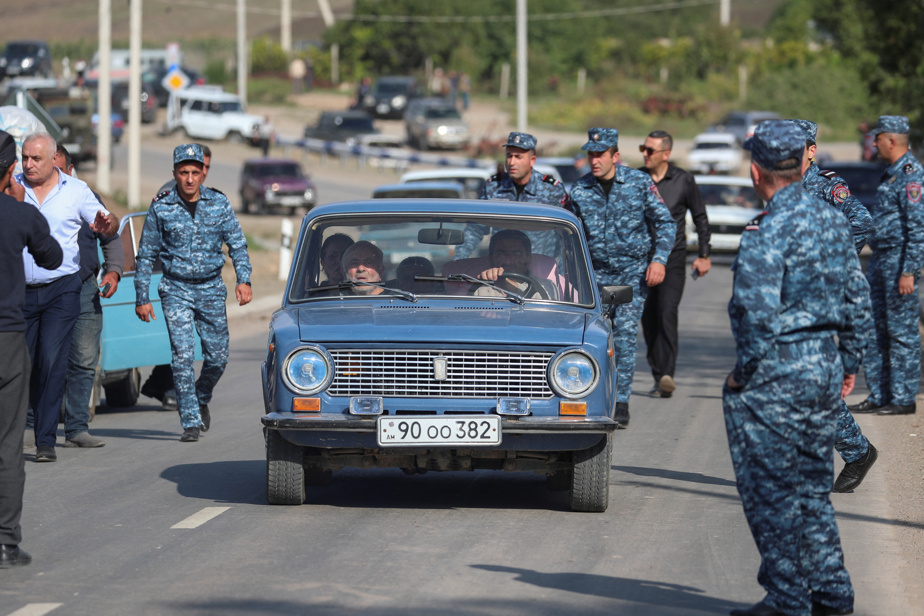(Kornidzor) Armenia prepares Monday to welcome a new flow of refugees from Nagorno-Karabakh, while a few hundred kilometers away Turkish President Recep Tayyip Erdogan meets his Azerbaijani counterpart Ilham Aliev in the Azerbaijani enclave of Nakhichevan .
The two leaders planned to organize a ceremony to lay the first stone of a new gas pipeline and to inaugurate an Azerbaijani military complex in this enclave nestled between Armenia and Iran, and attached to Azerbaijan since 1923 but without territorial continuity with Baku.
This Turkish show of force contrasts with Russia’s apparent withdrawal from the region, while some experts believe that for President Aliyev, annexing the Armenian Zangezour corridor, along the border with Iran, would establish continuity as far as Nakhichevan, and beyond, with Turkey.
Faced with demonstrations since Tuesday, Armenian Prime Minister Nikol Pashinian launched an implicit reproach to Russia for its lack of support after the victory of the Azerbaijani army against the separatists of Nagorno-Karabakh.
“The external security systems in which Armenia is involved have proven ineffective in protecting its security and interests,” he said on television, in a veiled allusion to his long-standing relations with Moscow inherited from the time when Armenia was part of the USSR.
“Territorial integrity”
Despite this crisis context, the long-planned meeting in Spain between MM. Aliev and Pashinian will take place on October 5, the Armenian authorities announced. Also present will be French President Emmanuel Macron, German Chancellor Olaf Scholz and President of the European Council Charles Michel.
The French president declared that “France is very vigilant about the territorial integrity of Armenia because that is what is at stake”, in a televised intervention on Sunday evening. “Today we have a Russia which is complicit with Azerbaijan, a Turkey which has always supported these maneuvers and a power which is uninhibited and which threatens the border of Armenia,” he added .
On Sunday, hundreds of refugees fleeing Nagorno-Karabakh entered Armenia from the reception center set up in Kornidzor.

PHOTO ALAIN JOCARD, AGENCE FRANCE-PRESSE
Refugees sit in a vehicle after registering at an Armenian Foreign Ministry center near the border town of Kornidzor on September 24.
According to the Armenian government, in total on Sunday evening, 377 “people forced to leave” crossed over to the Armenian side. According to the latest count from the Russian Defense Ministry, 311 civilians, including 102 children, were escorted by the Russian peacekeeping force on the Armenian side.
The authorities of Nagorno-Karabakh announced on Sunday that civilians left without housing due to the latest violence would be transferred to Armenia with the help of Russian peacekeepers, present there since the previous war, in 2020.
Azerbaijan has pledged to allow rebels who surrender their weapons to go to Armenia.
It is through the same Kornidzor border crossing that 23 ambulances transporting “seriously injured citizens” must pass, said the Armenian Ministry of Health.
No electricity, no fuel
A man interviewed by AFP in Kornidzor said he had been part of the “resistance” until Azerbaijan’s assault forced the rebels to capitulate on Wednesday.

REUTERS PHOTO
Azerbaijani servicemen displayed weapons and equipment allegedly seized from Nagorno-Karabakh Armenians during a recent military operation during a visit by foreign representatives and journalists to the Azerbaijani-controlled town of Shusha. , September 23.
“Our families were in the shelters. We were in the army but yesterday we had to lay down our rifles. So we left,” said this villager in his thirties who was waiting with others to be registered in the reception center.
Many fear that the local population will flee en masse as Azerbaijani forces tighten their grip.
Because in addition to the anxiety that reigns among the approximately 120,000 inhabitants of Nagorno-Karabakh, the humanitarian situation remains very tense.
Surrounded by Azerbaijani troops, its “capital”, Stepanakert, is deprived of electricity and fuel and its population lacks food and medicine, according to an AFP correspondent.
On Saturday, a first aid convoy from the International Committee of the Red Cross (ICRC) nevertheless entered Nagorno-Karabakh, while, from the UN platform in New York, Armenia demanded the “immediate” sending » from a United Nations mission, reiterating its accusations of “ethnic cleansing”.
Illustration, on the Azerbaijani side, of the deep traces left by the tormented history of this region, in the town of Beylagan, very close to Nagorno-Karabakh, a gallery of dozens of portraits of people killed three years ago or during the first conflict , flanked by Azerbaijani flags, line the main artery.
